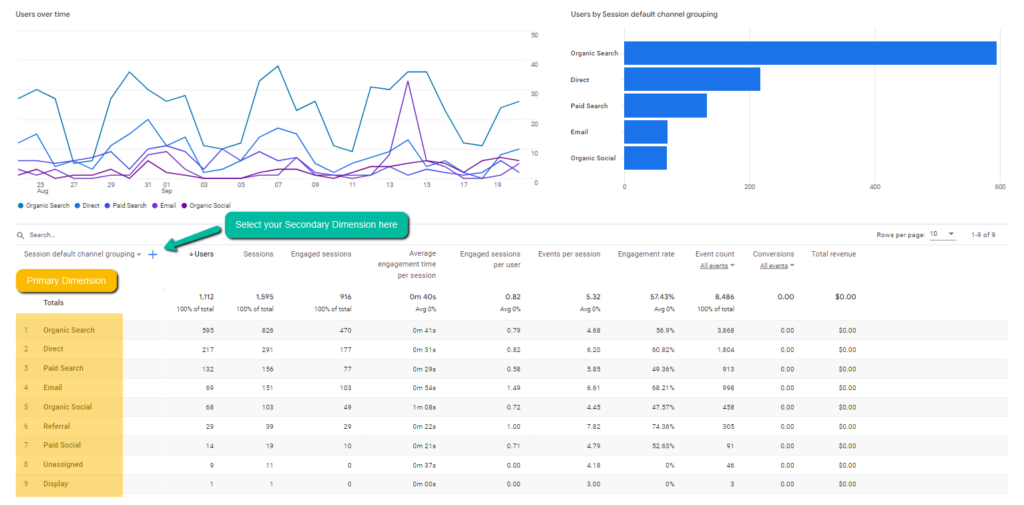Mastering Google Analytics: Using Secondary Dimension for Deeper Analysis
Wiki Article
Unlocking the Power of Additional Dimension Analytics for Enhanced Data Insights and Decision-Making
In the realm of data analytics, key measurements typically take the limelight, however the real depth of insights lies within the world of additional dimensions. By utilizing the power of second dimension analytics, organizations can unveil concealed trends, uncover correlations, and extract more meaningful conclusions from their information.
Relevance of Secondary Measurements
Discovering the relevance of additional dimensions in analytics reveals the surprise layers of information insights vital for informed decision-making in various domain names. Additional measurements give a much deeper understanding of main data by using added context and viewpoints. By integrating second dimensions into analytics, organizations can extract a lot more nuanced and thorough insights from their datasets.One secret importance of second measurements is their capacity to sector and categorize main information, permitting a much more detailed analysis of particular parts within a dataset. This division enables services to recognize patterns, patterns, and outliers that might not appear when checking out the information in its entirety. Additionally, additional measurements help in discovering correlations and reliances between different variables, causing even more accurate forecasting and anticipating modeling.
In addition, additional measurements play an essential role in improving information visualization and reporting. By adding additional dimensions to visualizations, such as charts or charts, analysts can create much more insightful and useful depictions of information, facilitating far better interaction of searchings for to stakeholders. On the whole, the assimilation of second dimensions in analytics is instrumental in opening the complete possibility of data and driving evidence-based decision-making.
Key Advantages of Using Additional Dimensions
Making use of additional measurements in analytics uses companies a calculated benefit by increasing the depth and granularity of data understandings. One crucial advantage of including additional measurements is the capability to segment and filter information, permitting a much more in-depth evaluation of certain aspects within a dataset. This division makes it possible for companies to obtain an extra nuanced understanding of their target market, efficiency metrics, and various other important data factors. By dissecting information using secondary measurements such as time, place, gadget kind, or user demographics, companies can discover patterns, trends, and correlations that might otherwise stay hidden.In addition, the use of secondary dimensions boosts the context in which key information is interpreted. By leveraging secondary dimensions in analytics, companies can harness the complete capacity of their information to drive far better decision-making and achieve their company objectives.
Advanced Data Analysis Strategies
A deep study innovative information analysis methods discloses sophisticated techniques for removing important insights from complicated datasets. One such strategy is artificial intelligence, where algorithms are employed to recognize patterns within information, forecast end results, and make data-driven decisions. This technique allows for the automation of logical version structure, allowing the handling of big volumes of information at a much faster speed than traditional approaches.An additional sophisticated technique is predictive analytics, which uses statistical formulas and artificial intelligence methods to anticipate future end results based upon historic data. By assessing fads and patterns, organizations can prepare for client behavior, market trends, and prospective dangers, encouraging them to make positive choices.
Moreover, message mining and view analysis are beneficial techniques for removing understandings from disorganized information sources such as social media comments, consumer testimonials, and study actions. By examining text data, companies can comprehend customer point of views, recognize emerging trends, and enhance their items or solutions based upon comments.
Enhancing Decision-Making With Additional Measurements

Enhancing decision-making with second measurements makes it possible for companies to make even more educated and targeted calculated selections. By segmenting consumer information based on secondary measurements like acquiring history or interaction levels, business can tailor their advertising approaches to details target market segments, leading to enhanced conversion prices and consumer satisfaction. Moreover, second measurements can help determine relationships and relationships between different variables, allowing organizations to make data-driven decisions that drive development and productivity.
Implementing Secondary Measurement Analytics
When incorporating secondary dimensions in analytics, organizations can unlock much deeper insights that drive calculated decision-making and improve general efficiency. special info Implementing additional dimension analytics requires a structured method to ensure reliable usage of this effective device. The initial action is to recognize the key metrics and dimensions that align with the organization's critical goals. This entails recognizing the specific inquiries the company seeks to answer and the data points called for to resolve them.
Furthermore, organizations should take advantage of advanced analytics devices and innovations to enhance the procedure of integrating secondary dimensions. These devices can automate information processing, analysis, and visualization, permitting organizations to concentrate on interpreting understandings instead of manual information manipulation.
Final Thought
In conclusion, secondary dimension analytics play a crucial function in enhancing information insights and decision-making procedures. By using sophisticated data analysis techniques and applying second measurements properly, organizations can open the power of their information to drive strategic service decisions. The crucial benefits of making use of secondary measurements can not be overstated, as they give a much deeper understanding of data fads and connections. It is necessary for companies to take advantage of additional measurement analytics to remain affordable in today's data-driven landscape.In the world of information analytics, primary measurements typically take the spotlight, but the real deepness of insights lies within the world of second dimensions.Using second dimensions in analytics offers companies a critical advantage by enhancing the deepness and granularity of data insights. By leveraging additional measurements in analytics, companies can harness the full potential of their data to drive better decision-making and achieve their business goals.
Applying information recognition processes and normal audits can aid maintain information quality and integrity.
By making use of advanced information analysis methods and carrying out see second dimensions effectively, organizations can unlock the power of their data to drive critical service choices.
Report this wiki page